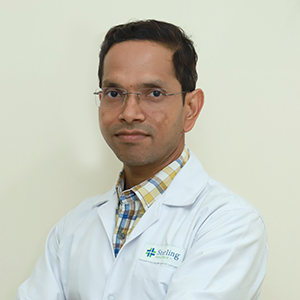Thoracic Surgery
Sterling Hospitals Rajkot is a leading hospital in , India that offers comprehensive care for patients with thoracic conditions. The hospital has a dedicated department of Thoracic Surgery that is staffed by a team of experienced surgeons who are experts in the diagnosis and treatment of these conditions.
Our team of experienced thoracic surgeons and trained staff work together to provide personalized treatment plans for each patient. We use the latest diagnostic tools and technology to accurately diagnose and manage a range of conditions.
The department offers a wide range of services, including:
-
Diagnosis: The department offers a variety of diagnostic services, such as chest x-rays, CT scans, and MRI scans.
-
Treatment: The department offers a variety of treatment options, including surgery, radiation therapy, and chemotherapy.
-
Follow-up care: The department offers comprehensive follow-up care to ensure that patients have the best possible outcome after treatment.
If you are concerned about your health, please schedule an appointment with a doctor at Sterling Hospitals Rajkot, . The doctor will be able to assess your symptoms and recommend the best course of treatment for you.
Thoracic Surgery
Thoracic surgery is a branch of surgery that deals with the diagnosis and treatment of diseases of the chest. The chest contains the lungs, heart, oesophagus, and other important organs. Thoracic surgeons are experts in the surgical treatment of these organs.
Following conditions are treated at Sterling Hospitals Rajkot, :
-
Lung Cancer
Lung cancer is a type of cancer that starts in the lungs. It is the most common cancer in the world, and the leading cause of cancer death in both men and women.
There are two main types of lung cancer: small cell lung cancer (SCLC) and non-small cell lung cancer (NSCLC). SCLC is a more aggressive type of cancer that tends to spread more quickly. NSCLC is a less aggressive type of cancer that can be treated more successfully.
-
Lung Cyst
A lung cyst is a saclike cavity that forms in the lung. It can be filled with air, fluid, or pus. Lung cysts are usually harmless, but they can sometimes cause symptoms such as shortness of breath, chest pain, or a cough.
There are two main types of lung cysts:
-
Congenital cysts: These cysts are present at birth and are usually caused by a defect in the development of the lungs.
-
Acquired cysts: These cysts develop later in life and can be caused by a variety of factors, including infection, inflammation, or trauma.
-
Pneumothorax
A pneumothorax is a collapsed lung. It happens when air leaks into the space between the lung and the chest wall. This air pushes the lung away from the chest wall, making it difficult to breathe.
There are two main types of pneumothorax:
-
Spontaneous pneumothorax: This type of pneumothorax happens for no apparent reason. It is more common in tall, thin men who smoke.
-
Traumatic pneumothorax: This type of pneumothorax is caused by a chest injury, such as a rib fracture or a stab wound.
-
Bronchiectasis
Bronchiectasis is a condition in which the airways in the lungs become enlarged and damaged. This can cause a number of problems, including difficulty breathing, coughing up mucus, and infections.
The airways in the lungs are made up of small tubes that carry air to and from the lungs. Bronchiectasis occurs when these tubes become enlarged and damaged. This can happen for a number of reasons, including:
-
Infection: Bronchiectasis can be caused by a number of infections, including pneumonia, tuberculosis, and whooping cough.
-
Genetics: Some people may be more at risk for bronchiectasis due to their genetics.
-
Immune system problems: People with immune system problems, such as cystic fibrosis, are more likely to develop bronchiectasis.
-
Trauma: Trauma to the chest, such as a rib fracture, can damage the airways and lead to bronchiectasis.
-
Chest Trauma
Chest trauma is an injury to the chest that can be caused by a variety of factors, including:
-
Blunt force trauma: This type of trauma is caused by a sudden, forceful impact to the chest, such as from a car accident or a fall.
-
Penetrating trauma: This type of trauma is caused by an object that pierces the chest, such as a knife or a bullet.
-
Inhalation injuries: These injuries are caused by breathing in hot or toxic fumes, such as from a fire or a chemical spill.
-
Lung Nodule
A lung nodule is a small, round area of tissue that appears on a chest X-ray or CT scan. Nodules can be caused by a variety of things, including:
-
Benign tumors: These are non-cancerous tumors that do not spread to other parts of the body.
-
Malignant tumors: These are cancerous tumors that can spread to other parts of the body.
-
Infections: These can be caused by bacteria, viruses, or fungi.
-
Inflammation: This can be caused by a variety of things, including allergies, autoimmune diseases, and infections.
-
Scar tissue: This can be caused by previous injuries or surgeries.
The size of a lung nodule can vary from a few millimetres to a few centimetres. Nodules that are smaller than 1 centimetre are often called "micronodules".
- Oesophageal Cancer
Oesophageal cancer is a type of cancer that starts in the oesophagus, which is the tube that carries food from your throat to your stomach. It is the ninth most common cancer in the world and the sixth most common cause of cancer death.
There are two main types of oesophageal cancer: squamous cell carcinoma and adenocarcinoma. Squamous cell carcinoma is the most common type of oesophageal cancer, accounting for about 90% of cases. Adenocarcinoma is the second most common type of oesophageal cancer, accounting for about 10% of cases.
- Myasthenia Gravis & Thymoma
Thymic Neoplasms and Myasthenia Gravis Overview. Thymic neoplasms are tumors that develop in the thymus gland. People with thymic neoplasms frequently have myasthenia gravis — a chronic, progressive autoimmune disorder that causes the muscles of the head, face, and body to become weak and easily fatigued.
- Palmar Hyperhidrosis
Palmar hyperhidrosis is a condition that causes excessive sweating in the palms of the hands. It is the most common form of hyperhidrosis, which is excessive sweating in general.
- Posterior Mediastinal Tumour
A posterior mediastinal tumor is a mass that grows in the posterior mediastinum, which is the middle part of the chest behind the heart and lungs. Posterior mediastinal tumors are rare, accounting for only about 10% of all mediastinal tumors.
The most common types of posterior mediastinal tumors are:
-
Neurogenic tumors: These tumors are made up of nerve tissue and include neurofibromas, schwannomas, and ganglioneuromas.
-
Germ cell tumors: These tumors are made up of germ cells and include teratomas, seminomas, and germ cell tumors with mixed elements.
-
Lymphomas: These tumors are made up of lymphocytes and include Hodgkin lymphoma and non-Hodgkin lymphoma.
-
Oesophageal tumors: These tumors are made up of cells that line the oesophagus and include squamous cell carcinomas and adenocarcinomas.
Types of Thoracic Surgery
There are many different types of thoracic surgery, but some of the most common include:
-
Lung cancer surgery: Lung cancer is the most common cancer in the chest. Thoracic surgeons perform a variety of lung cancer surgeries, including lobectomy (removal of a lobe of the lung), pneumonectomy (removal of the entire lung), and wedge resection (removal of a small piece of the lung).
-
Heart surgery: Heart surgery is a broad term that encompasses a variety of procedures to treat heart conditions. Thoracic surgeons perform many different heart surgeries, including coronary artery bypass grafting (CABG), valve replacement, and heart transplant.
-
Oesophageal surgery: The oesophagus is the tube that carries food from the throat to the stomach. Thoracic surgeons perform a variety of oesophageal surgeries, including esophagectomy (removal of the oesophagus), fundoplication (reconstruction of the lower oesophagus), and Heller myotomy (relaxation of the lower oesophageal sphincter).
-
Mediastinal surgery: The mediastinum is the area in the chest that contains the heart, lungs, oesophagus, and other important structures. Thoracic surgeons perform a variety of mediastinal surgeries, including thymectomy (removal of the thymus gland), pericardiectomy (removal of the pericardium), and lymph node dissection.
Diagnosis and Treatment of Thoracic Conditions
The diagnosis of thoracic conditions typically begins with a physical exam and a review of the patient's medical history. The doctor may also order imaging tests, such as chest x-rays, CT scans, or MRI scans. These tests can help to identify abnormalities in the chest and to determine the cause of the patient's symptoms.
The treatment of thoracic conditions depends on the underlying condition. Some common treatments include:
-
Surgery: Surgery is often the treatment of choice for thoracic conditions, such as lung cancer and heart disease.
-
Radiation therapy: Radiation therapy is used to kill cancer cells. It can be used before or after surgery, or as a primary treatment for some conditions.
-
Chemotherapy: Chemotherapy is the use of drugs to kill cancer cells. It can be used before or after surgery, or as a primary treatment for some conditions.
-
Medications: Medications can be used to treat a variety of thoracic conditions, such as infections and autoimmune disorders.
Thoracic surgeons diagnose and treat a variety of conditions of the chest, including:
-
Cancer: Thoracic surgeons are experts in the diagnosis and treatment of cancer of the lung, heart, oesophagus, and other organs in the chest.
-
Infections: Thoracic surgeons treat infections of the lungs, heart, and other organs in the chest.
-
Structural abnormalities: Thoracic surgeons treat structural abnormalities of the chest, such as congenital heart defects and collapsed lungs.
-
Trauma: Thoracic surgeons treat injuries to the chest, such as those caused by car accidents or falls.
Prognosis of Thoracic Conditions
The prognosis of thoracic conditions depends on the underlying condition and the stage of the disease at the time of diagnosis. However, with early diagnosis and treatment, many thoracic conditions can be successfully managed.
If you are concerned about your health, please schedule an appointment with a doctor. Early diagnosis and treatment are the best way to improve your chances of a good outcome.
The Benefits of Thoracic Surgery
Thoracic surgery can provide many benefits for patients with chest conditions. These benefits can include:
-
Improved quality of life: Thoracic surgery can improve the quality of life for patients with chest conditions by relieving symptoms, such as shortness of breath, pain, and coughing.
-
Increased survival rates: Thoracic surgery can increase the survival rates for patients with certain conditions, such as lung cancer and heart disease.
-
Improved function: Thoracic surgery can improve the function of organs in the chest, such as the lungs and heart.











